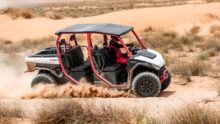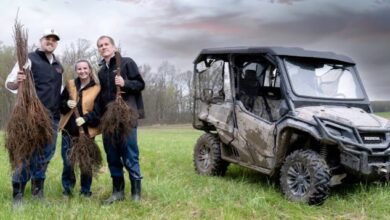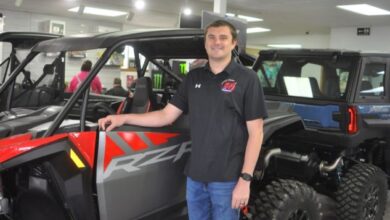ATV – 2005 Features Few New Machines, Many Upgrades
Redesigns are the ticket this year in the ATV business. However, that doesn’t mean the manufacturers are taking the easy way to the showroom floor. Many of the 2005 updates are intense, thorough and impressive.
As the ATV industry expanded in the last five years, so did the lineups from the big manufacturers. Now, instead of having a few core machines to focus on, the OEMs have a bevy of quads in each niche that have to be placed on cycles for redesigns and new additions.
Most OEMs worked to make their machines look new for 2005, whether the lineups contain new models or major upgrades.
In fact, there are several new quads to present to your customers — from the Polaris Sportsman MV to the Suzuki King Quad. Here’s a summary of the lineup changes from each major OEM.
ARCTIC CAT IMPROVES 500CC MODELS
The Arctic Cat 500 models are a good example of this push to upgrade. From the manual 500 to the TBX, the whole line went under the knife to improve on last year’s models. They have new styling with cat-eye headlights, wider fenders, a redesigned seat, integrated floorboards and a new taillight. Also, a new storage compartment where the fuel tank once lived makes its debut and the 6.5-gallon gas tank is now located in the rear of the machine.
Arctic Cat cut deeper than the surface with this redesign. The 500s now have a full-lock front differential, a heavy-duty rear axle and floating brake calipers. For 2005, the foot brake system was redesigned to include a remote reservoir and new master cylinder, the switch for 4×4/2×4 capabilities has been relocated to the right-side handlebar to improve operation and the MRP Speedracks have a new shape.
Even the manual transmission model got a makeover with a new two-piece shifter that allows the rider to choose either heel/toe shifting or toe-only shifting.
Arctic Cat also redesigned the 500 TBX’s cargo box. Now it has a 400-pound capacity, built-in tie-down attachment points and integrated channeled rails for the accessory clamp-down fixture. Even the latch on the tailgate has been reworked and new latches were added to the box so the load can be “dumped” from either side of the cargo box.
The Arctic Cat 500 4×4 TRV (Two Rider Vehicle) received a new heavy-duty rear axle, like the one found on the AC 650. It also has floating brake calipers and a redesigned foot brake system (like the 500 4×4 models).
The Arctic Cat 650 V2 Twin 4×4 received several updates for 2005, though not as massive as the changes to the 500 line. Arctic Cat claims this incarnation of the Kawasaki-made V2 is quieter due to a new sealed air intake located near the front of the quad. The 650 V2 sports a new foot brake system with remote reservoir and a new master cylinder to provide improved stopping feel.
The 650 V2 Twin also gets an access tool tray located under the seat and a new latch was installed to make removal of the seat easier. To top it all off, the machine received the body work upgrades seen on the 500 line, which includes wider fenders, integrated floorboards, textured rear fender panels, restyled instrument pod, new taillight and cat-eye headlights.
HONDA REWORKS FOREMAN
The ever-popular Honda Foreman 4×4 has been reworked significantly in that its past 433cc engine has been pumped up to a 475cc. The new four-stroke is longitudinally mounted to allow direct drive shaft alignment to both front and rear wheels, which Honda claims will improve drivetrain efficiency.
The beefier engine’s new oil-cooling system features dual oil coolers for greater cooling capacity. The Foreman also has new dual front disc brake calipers, which replace drum brakes.
To add some newness to the line, a 2WD, manual-shift only model is available this year.
KODIAK GETS MAJOR CHANGES
The Yamaha Kodiak 400 4×4 under went considerable renovations for 2005. The biggest change is its new independent rear suspension. The old solid rear axle was replaced to provide a more comfortable and agile machine the entire family can enjoy. The IRS also increases the quad’s ground clearance to 10.8 inches from last year’s 9.7 inches.
Since the rear suspension was improved, the rear hydraulic brakes were too. To top it all off, literally, the Kodiak 400 4×4 received new, stylish-yet-tough plastic, along with new CV joint guards that will prevent CV boot cover damage.
Yamaha also fitted the Kodiak 450 4×4 with IRS, along with new body work.
PREDATOR EASIER TO RIDE
The Polaris Predator 500 got tweaked in the ergonomics department. A redesigned seat with more foam padding and repositioned handlebars (1 inch taller) make riding the machine more comfortable.
The rev limiter has been increased, upping the top-end power and acceleration. Another gearing difference is the addition of reverse gear, which should make this quad more appealing to consumers.
The Troy Lee Designs Edition sports a special graphics package: orange body work with black and silver trim. It has new Maxxis Razr PR radial tires and Douglas aluminum rims, aluminum FOX front and rear shocks and new gearing.
WHAT’S OLD IS NEW
Sometimes an overhaul isn’t enough to keep an ATV fresh in the minds of consumers. Manufacturers are reluctant to just toss machines out of the lineup after years of research and development. The logical answer to the problem is another trend for 2005: resurrect and rename.
To expound on the newest nameplate, the Brute Force, Kawasaki introduced the Brute Force 650. It may seem like a new machine, but underneath it all it’s an updated Prairie 650. The defunct Prairie 650 held its ground in 2003, disappeared in 2004 and this year the 90-degree V-twin makes a comeback. Now only answering to the name Brute Force, the 650 is a welcome makeover. The price alone should make it a customer favorite. With the face of ATVs and enthusiasts ever-changing, this is a trend we could see grow in the coming years.
By the same token, Yamaha Raptor 350 is the newest member of the sporty Raptor family. What’s underneath that ravenous plastic is the recently dismissed Warrior 350 with some tweaks. It gained some race-inspired parts from the Raptor 660R and the YFZ450 to make it zippier than before. The 350 retained the easy-to-use 6-speed transmission from the Warrior that has long been a family favorite.
MINOR MODIFICATIONS
Once major overhauls are completed, attention can be paid to machines that are perhaps only a few years old and/or in fine mechanical shape. These minor to moderate redesigns can still pack a powerful punch, though.
The entire Polaris Sportsman line was redesigned, but only aesthetically. The new plastic, from the 700 to the 400, looks fresh and sleek, which will be noticed in the showroom. Most of the Sportsman line also received Polaris’ new PXT tires and a water-resistant front storage box lid.
Honda gave a less-than-major makeover to the FourTrax Foreman Rubicon. The Rubicon received redesigned plastic, which Honda claims gives it a more “rugged, adventurous look.” The bodywork incorporates an integrated storage compartment and a reworked meter assembly with a new digital fuel gauge. But it’s not all cosmetic improvements for the Rubicon: It now stops via 180mm front disc brakes with single caliper pistons. Also new this year is the addition of the TraxLok system to maneuver the machine from 2WD to 4WD.
The 400EX tries to be a little bit more like it’s big brother by sporting TRX450R plastic this year. It also received reverse gear, which should make it even more popular than years past, and a revised carburetor. All the Honda Recon 2×4 got was a facelift, making the plastic more “SUV-like.”
Suzuki put a new throttle pulley system, for lighter lever operation and quicker engine response, on most of its utility ATVs including the Eiger. The Eiger’s makeover includes updated plastic that incorporates a redesigned front guard and new multi-reflector headlights.
A number of other machines from just about every manufacturer received minor tweaks such as new graphics, foot pegs and updated instrument pods.
MEANS TO AN END
The new 2005 machines have been released, the redesigns are complete and the ATVs are uncrated. When manufacturers redesign current ATVs, dealers and consumers benefit. Dealers have a full arsenal of ATVs at the ready, with R&D time built in, which translates into customers having well-planned new quads in their garages, fewer complaints and a new batch of redesigned ATVs to look forward to next year.








